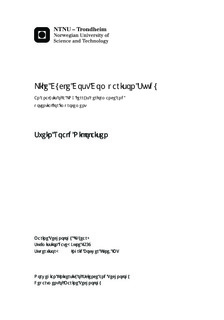| dc.description.abstract | A life cycle cost comparison study between a newly built LNG ferry and a 21 year old conventional ferry was carried out in this study. The objective was to study the LNG vessel s cost effectiveness compared to an equivalent existing vessel of mature age. It has been assumed that both vessels are to be operating according to the LNG vessel s current production pattern at a specific ferry service. The study has a time span of 30 years. Another assumption is that both vessels are assumed to be procured from respectively the newbuilding market and the second-hand market.
This study emphasises primarily vessel generated costs. The cost elements that are investigated are among other: capital costs, fuel costs, lube oil costs, maintenance costs, downtime costs, NOx emission costs and income due to scrapping. Costs such as port fees and management costs are not included. Due to the high level of uncertainty related to many of the cost elements, a sensitivity analysis is performed.
A cost breakdown structure has been derived to identify the relevant cost elements which are to be studied. Data are gathered from the shipping company that owns the vessels. This is done by use of their databases and records. Documentations and specifications are also provided by the shipping company s suppliers. Estimations which lacked sufficient input data have been partly founded on expert opinions.
It has been found that the total life cycle costs of the conventional vessel are 12 % lower than the LNG vessel s. The most significant cost elements are identified to be the capital costs, fuel costs, maintenance costs, NOx emission costs and downtime costs. If an internal rate of return is applied, the LNG vessel s disadvantage when it comes to total life cycle costs will increase. This is due to the LNG vessel s high initial costs.
The results show that the capital costs related to the procurement of the conventional vessel in real term value are only 8 % of the LNG vessel s capital cost. It has been found that the conventional vessel has 19 % lower energy consumption than the LNG vessel. Despite of this, it is estimated that the conventional vessel will have 9 % higher total fuel cost over the time period. The main reason for this is that the existing gap between the two energy prices is forecasted to increase over the time period.
It is estimated that the LNG vessel has 9 % lower maintenance cost over the time period. One of the reasons for this is the expectation of reduced deterioration of the fuel supply system and other components such as engine nozzles and exhaust valves.
The LNG vessel s total NOx emission costs are estimated to be only 15 % of the conventional vessel s, which is one of the most significant differences between the ferries. This is due to the LNG engine s ability to operate at very low NOx emission rates.
An analysis regarding a measure that may reduce the LNG vessel s life cycle cost is also conducted. The vessel has installed a hybrid shaft generator system. The main engine is able to deliver power to the vessel s electricity grid by use of the shaft generator. Vice versa, the shaft generator is able to function as a motor and thus use electric power for propulsion. In other words, the shaft generator gives the vessel flexibility with respect to power consumption and power production. The measure is to replace the LNG vessel s shaft generator with a new unit which has sufficient capacity to supply all the main switchboard s consumers without having to run the vessel s standby generator. Then the main engine will alone be able to provide sufficient electricity power to the vessel s grid. This is assessed to enable savings of fuel, NOx tax and maintenance cost due to among other increased efficiency of electricity production.
Data for this analysis regarding the current operation of the propulsions system is gathered from the LNG vessel s power management system. Information regarding the system s components is provided by the suppliers.
It has been found that the yearly savings due to the reduced fuel, maintenance and NOx expenditures are in lower edge of 1 million NOK. This measure will reduce the vessel s NOx emission significantly. The measure therefore qualifies to a significant support from the Norwegian NOx fund, which may reduce the financial cost of the replacement to about 1 million NOK. Consequently, the payback time is about one year, which is a relatively short time period. However, it is important to underline that there is uncertainty related to these calculations and the inherent limitations which are associated with the measure. | |

